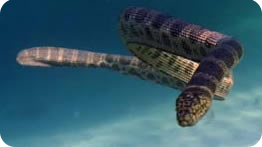Sailors have been telling tales of sea serpents for as long as they’ve been going to sea -- stories of long monsters that could pluck men from the deck of a ship.
 Sea snake. Courtesy of the Shark Bay Ecosystem Research Project
Sea snake. Courtesy of the Shark Bay Ecosystem Research ProjectThere really are sea serpents, and they can be deadly. But instead of monsters as big as ships, they’re only a few feet long. They’re snakes -- relatives of the reptiles that slither across land.
Sea snakes are found in the tropical waters of the Indian and Pacific Oceans, like Australia’s Great Barrier Reef. They’re not in the Atlantic, because there’s no warm-water route to get them there. But, who knows, warming waters could make it possible for sea snakes to make their way to the Atlantic.
Sea snakes look pretty much like land snakes, although some species have flat tails that they use for swimming. They have to come to the surface to breathe, but their lungs can stretch the length of their bodies. And while underwater, they can take in oxygen through their skin. The combination allows them to remain submerged for quite a while.
There are about 70 species of sea snakes, and most are venomous. In fact, the venom of some species is deadlier than that of most land snakes. But most sea snakes aren’t very aggressive, so they’re slow to bite. And when they do bite, they usually don’t inject much venom. But when they inject enough venom, it can dissolve muscles and cause paralysis -- killing just as surely as any sea serpent in the legends of old.

